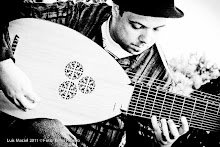 An opportunity arose to do something interesting that I did not imagine for some time: historical research. The idea came almost simultaneously between me and my teacher, but in different and complementary ways.
An opportunity arose to do something interesting that I did not imagine for some time: historical research. The idea came almost simultaneously between me and my teacher, but in different and complementary ways.
Since the beginning of my course I had the idea of playing a Carlos Seixas sonata for harpsichord with an archlute, closing a technical level graduation recital with a tribute and reference to my native country. At the beginning of the course I had the delightful experience of being able to play "Cancioneiro Musical de Belém" - A manuscript of the late sixteenth century/Early seventeeth Century – in a small group. My teacher got a copy of this work, directed by Manuel Morais.
A year ago, I also got a divine CD of Frei Manuel Cardoso, by "The Tallis Scholars," and the last Pedro Caldeira Cabral CD, with some adaptations for plucked strings instrument of Portuguese Renaissance composers.
However, by having access to the library of the School of Music of Brasilia-EMB, I found a good deal of information about ancient Portuguese music, and historical details that connect some of the most famous Spanish musicians in Portugal. In fact, I begin to believe that much of the portuguese Early Music may have survived the catastrophic earthquake of 1755, contrary to traditional belief, and that I may contribute to complement the work of artists such as "The Tallis Scholars," Pedro Caldeira Cabral and Manuel Morais, in my humble scale: for now, the preparation of a small Portuguese music recital that has not yet been recorded.
(Português)
Surgiu uma oportunidade interessante de fazer algo que não me imaginava há algum tempo: Pesquisa histórica. A idéia surgiu praticamente em simultâneo entre mim e o meu professor, mas de maneiras diferentes e complementares.
Desde o início do meu curso que tinha a idéia de tocar uma sonata para cravo de Carlos Seixas num arquialaúde, fechando um recital de formatura no nível Técnico com uma homenagem e referência ao meu país natal. No começo do curso tive a experiência deliciosa de poder tocar o “cancioneiro musical de Belém” – um manuscrito do final do Século XVI/Início do Século XVII - num pequeno grupo. O meu professor conseguiu uma cópia dessa obra, dirigida por Manuel Morais.
Há um ano adquiri também um CD divinal de Frei Manuel Cardoso, pelos “The Tallis Scholars”, e o último CD de Pedro Caldeira Cabral, com algumas adaptações para instrumento de cordas de outros compositores renascentistas portugueses.
Porém, ao ter acesso à biblioteca da Escola de Música de Brasília-EMB, encontrei uma boa quantidade de informação sobre música antiga portuguesa, e detalhes históricos que ligam alguns dos mais famosos músicos espanhóis a Portugal. De facto, começo a acreditar que boa parte da Música Antiga portuguesa poderá ter sobrevivido ao catastrófico terramoto de 1755, ao contrário do que tradicionalmente se acredita, e que poderei contribuir para complementar o trabalho de artistas como os “The Tallis Scholars”, Pedro Caldeira Cabral ou Manuel Morais, à minha humilde escala: para já, a preparação de um pequeno recital de música portuguesa que ainda não tenha sido gravada.



Parabéns pela descoberta do fascinante mundo da pesquisa - bibliográfica, científica, arqueológica, musical...todas as pesquisas. A pesquisa é sempre gratificante, mesmo quando não se obtém os resultados desejados. Porém, nos casos apresentados, parece haver muito a descobribrir. Força nisso! ARC
ReplyDelete